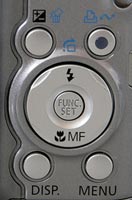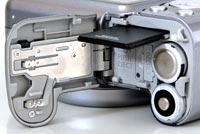Canon Powershot A710 IS Review
Review Date: October 28th 2006
Leave a Comment about this Review
|
Ease of Use
The Canon Powershot A710 IS is a very well-made, quite compact digital camera, with a stylish dark silver plastic body and excellent overall finish. It's just about small enough to fit into the palm of your hand, which is quite remarkable considering the 6x optical zoom lens that's equivalent to a 35-210mm focal length. The A710 IS is quite thick though at just over 4cms, making it more suited to a small camera bag rather than a trouser pocket. It has a reassuring weight of 210g without the battery or memory card fitted. As with most Canon cameras that we have reviewed before, the Powershot A710 IS is one of the better models in terms of build quality. Every aspect has a quality feel with nothing feeling flimsy or ill-thought out. The main criticism that can be leveled at the Canon Powershot A710 IS are that the tripod mount is plastic instead of metal and it's positioned in the extreme left corner of the bottom of the camera. Also, the battery compartment houses the memory card slot, which means that the AA batteries sometimes fall out when changing the memory card as they don't have a catch to keep them in place.
The Canon Powershot A710 IS is comfortable to hold thanks largely to the chunky, rubberised hand-grip. Your left thumb naturally supports the bottom of the camera, whilst operating the shutter button with your right index finger and gripping the back of the camera with your right thumb. You can also comfortably hold the camera and take pictures with one hand. Despite the smooth all-metal body, the camera is not too slippy when gripping it. The various buttons are well-made and easy to operate, and the camera feels well-balanced in your hands. There are no real innovative features here, but everything that the Canon Powershot A710 IS does, it does extremely well. Overall the Canon Powershot A710 IS is well constructed and designed with no obvious signs of corners being cut.
The Canon Powershot A710 IS has relatively few external controls, just 11 in total, which belies the fact that this is quite a complex in functionality terms, with full photographic control on offer. You can directly access the various flash and focus options by clicking up and down on the navigation pad, whilst left and right is used to set aperture and shutter speeds when using the more creative shooting modes. Canon have also added a dedicated button to Exposure Compensation, which is a commonly used feature. There is also a sub-menu accessed via the Function/Set button in the middle of the navigation pad, which allows you to set ISO speed, white balance, drive mode, image effects, flash compensation, metering and image size/quality settings. This system is a good compromise given the small size of the camera and therefore the limited space for external controls. All 11 external controls are clearly labeled using industry-standard symbols and terminology. Overall the camera body feels very well-designed and not at all cluttered, despite the presence of the large 2.5 inch LCD screen. A small optical viewfinder is also included, which is welcome for moments when it is difficult to use the LCD screen i.e. in very bright sunlight. I found it to be a little on the small side, however, so you will probably find yourself using the LCD screen most of the time.
| Mode Dial | The Main Controls |
 |
 |
If you have never used a digital camera before, or you're upgrading from a more basic model, reading the comprehensive and fairly easy-to-follow manual before you start is a good idea. Unfortunately Canon have chosen to cut costs and only supply the full manual as a PDF on a CD, rather than in printed format (there's just a short printed guide to the camera's basic features). Not much use if you're taking pictures and need to find out what a particular option does.
The menu system on the Canon Powershot A710 IS is extremely straight-forward to use and is accessed by a dedicated button underneath the navigation pad. Quite a lot of the camera's main settings, such as white balance, exposure compensation and ISO speed, are accessed elsewhere, so the main menu system isn't actually that complicated. A row of 3 icons along the top of the LCD screen represents the various sub-menus, with most of them being the kind that you set once and then forget about. Due to the very large and bright LCD screen, the various options are easy to access and use, especially as only 6 are shown onscreen at one time.
The Canon Powershot A710 IS offers full photographic control over aperture and shutter speed, with Aperture-priority, Shutter-priority and full Manual available. There are also Program, full Auto and a range of different scene modes aimed at the user who just wants to point and shoot, making this camera suitable for a wide variety of people. It also offers some features that you won't find on other digital cameras. Press the Function button and select the My Colors option to reveal the Custom Color menu, which includes a number of pre-set looks, such as Positive Film and Vivid Green. These are a quick way of achieving a particular effect. More exciting are the Color Accent and Color Swap options, which are now available via the Scene Mode menu. Color Accent allows you to select one colour and render the rest of the image in black and white, whilst Color Swap lets you select a colour in the image and change it for another completely different one. As far as I know, Canon are the only manufacturer to offer what is quite an advanced feature directly in their cameras
There is a great feature on the Canon Powershot A710 IS that aims to make life easier for you. This camera has an anti-shake system, dubbed IS Mode - turn it on and the A710 IS automatically compensates for camera shake, which is a slight blurring of the image that typically occurs at slow shutter speeds. There are three different modes. Continuous is on all the time including image composition, Shooting is only on when you press the shutter button, and Panning as the name suggests is best when using the camera to track a moving subject. In practice I found that it does make a noticeable difference, as shown in the examples on the Image Quality page. You don't notice that the camera is actually doing anything different when anti-shake is turned on, just that you can use slower shutter speeds than normal and still take sharp photos. Leaving the anti-shake system on all the time does seem to affect the battery-life, however, with the camera only managing just over 100 shots before the 2000 mAh AA batteries needed to be recharged.
| Memory Card Slot | Battery Compartment |
 |
 |
The start-up time from turning the Canon Powershot A710 IS on to being ready to take a photo is quite quick at around 1 second, and it takes about 3 seconds to zoom from the widest focal length to the longest. Focusing is very quick in good light and the camera happily achieves focus indoors or in low-light situations, helped by a powerful focus-assist lamp. The visibility and refresh rate of the 2.5 inch LCD screen are perfectly acceptable, although the resolution is on the low side at just 115,000 pixels, making the picture quite grainy. It takes about 0.5 second to store an image, allowing you to keep shooting as they are being recorded onto the memory card - there is no LCD blackout between each image. In Continuous mode the camera takes 1.7 frames per second at the highest image quality, which isn't particularly quick for this class of camera, although the shooting rate is maintained until your memory card is full! Not so great is the flash recycle time, which takes 5 seconds to recharge between shots. All in all the Canon Powershot A710 IS is quick in terms of operational speed.
Once you have captured a photo, the Canon Powershot A710 IS has a good range of options when it comes to playing, reviewing and managing your images. You can instantly scroll through the images that you have taken, view thumbnails, zoom in and out up to 10x magnification, view slideshows, delete, protect, and rotate an image. You can also add a sound clip to an image, set the print order and the transfer order. The Display button toggles detailed settings information about each picture on and off, such as the ISO rating and white balance, and there is a small histogram available during playback which is helpful in evaluating the exposure.
In summary the Canon Powershot A710 IS is a stylish, quite compact and well-built digital camera that offers a wide variety of shooting modes, from fully manual to fully automatic.
|
![]() PhotographyBLOG
is a member of the DIWA
organisation. Our test results for the Canon Powershot A710
IS have been submitted to DIWA
for comparison with test results for different samples of
the same camera model supplied by other DIWA
member sites.
PhotographyBLOG
is a member of the DIWA
organisation. Our test results for the Canon Powershot A710
IS have been submitted to DIWA
for comparison with test results for different samples of
the same camera model supplied by other DIWA
member sites.
